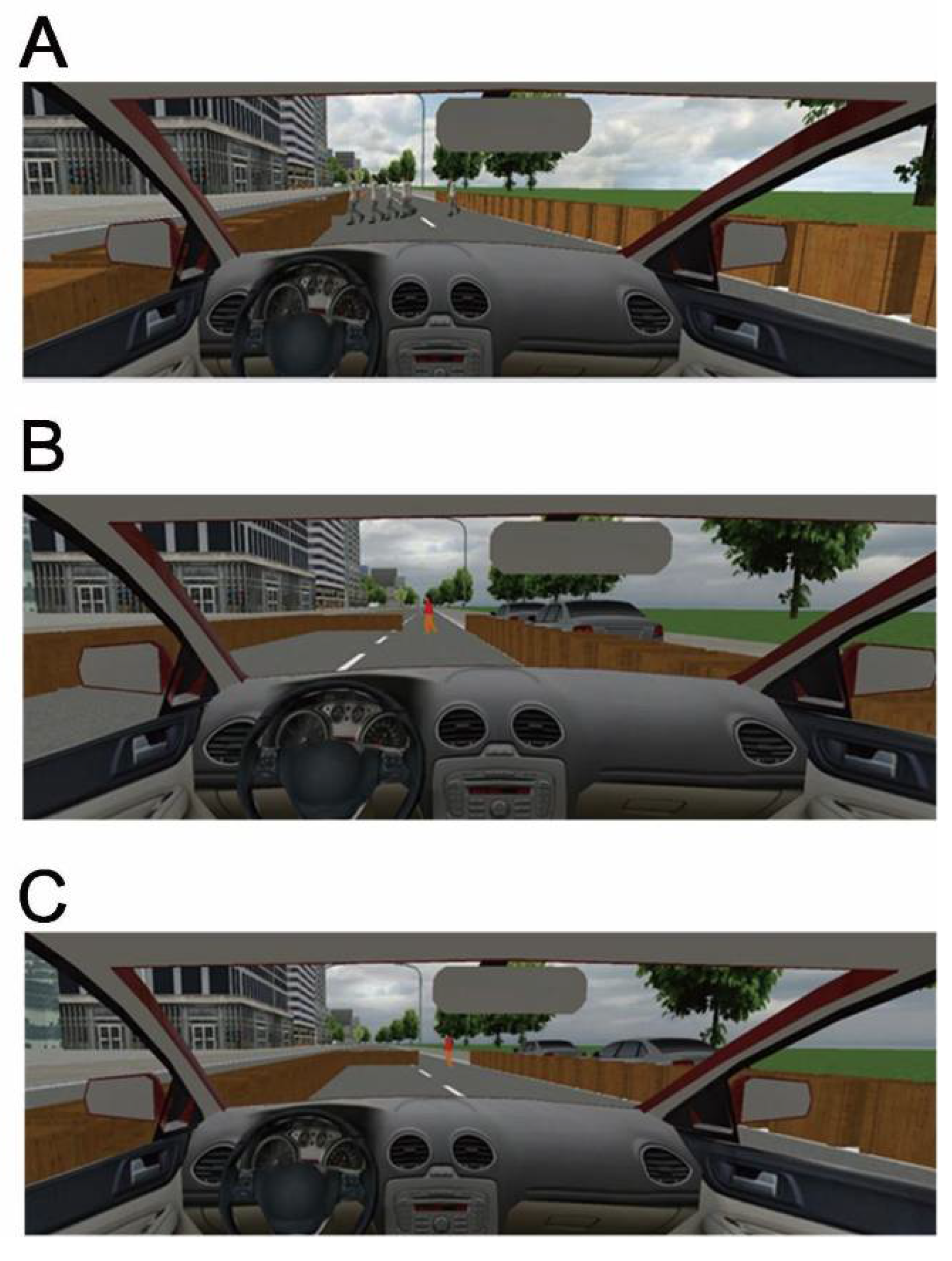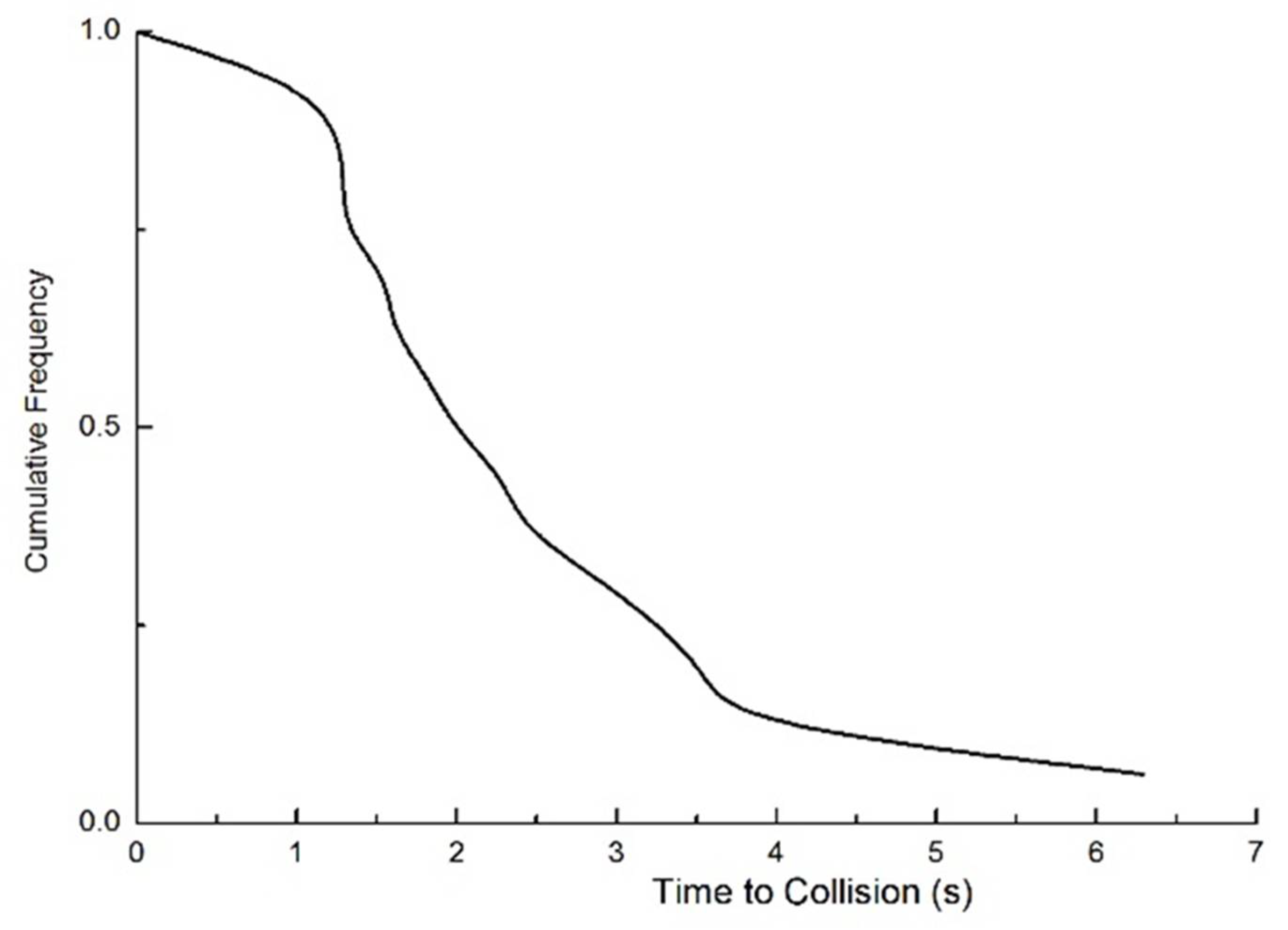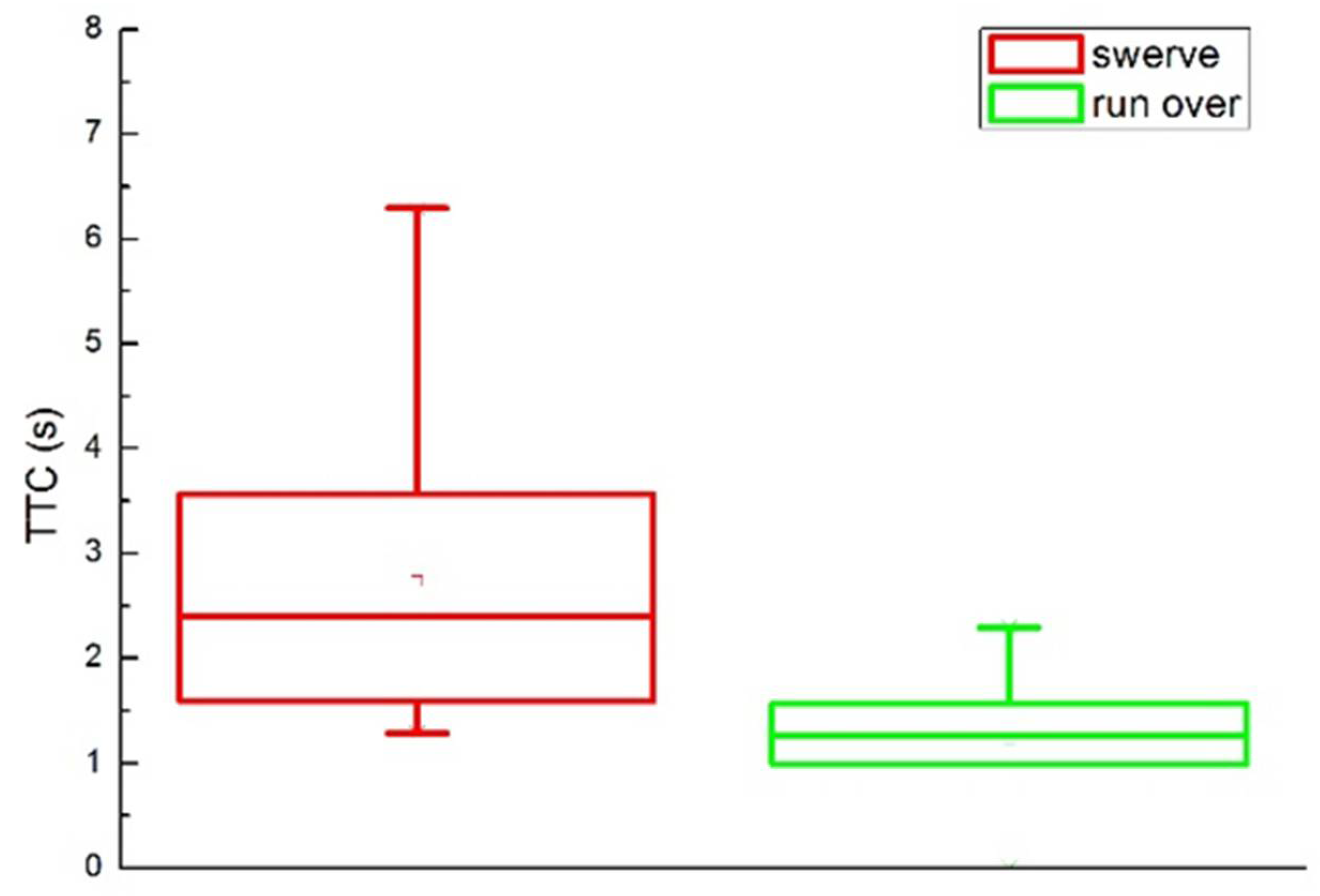Driving Behavior and Decision Mechanisms in Emergency Conditions
Abstract
:1. Introduction
2. Experiment Methods
3. Results
4. Discussion
Author Contributions
Funding
Institutional Review Board Statement
Informed Consent Statement
Data Availability Statement
Conflicts of Interest
References
- Foot, P. The Problem of Abortion and the Doctrine of Double Effect’, in her Virtues and Vices. In FootThe Problem of Abortion and the Doctrine of the Double Effect19Virtues and Vices1978; University of California Press: Berkeley/Los Angeles, CA, USA, 1978; pp. 19–32. [Google Scholar]
- McFarland, M. Who’s Responsible When an Autonomous Car Crashes? Available online: https://www.karnskerrisonlaw.com/blog/2021/september/who-is-responsible-for-self-driving-car-accident/#:~:text=The%20liable%20party%20will%20likely,the%20eyes%20of%20the%20law (accessed on 2 July 2020).
- MoralMachine. Available online: https://www.moralmachine.net/ (accessed on 8 July 2018).
- Bonnefon, J.-F.; Shariff, A.; Rahwan, I. The social dilemma of autonomous vehicles. Science 2016, 352, 1573–1576. [Google Scholar] [CrossRef] [PubMed] [Green Version]
- Awad, E.; Dsouza, S.; Kim, R.; Schulz, J.; Henrich, J.; Shariff, A.; Bonnefon, J.F.; Rahwan, I. The moral machine experiment. Nature 2018, 563, 59–64. [Google Scholar] [CrossRef] [PubMed]
- Gao, Z.; Sun, Y.; Hu, H.; Zhang, T.; Gao, F. Investigation of the instinctive reaction of human drivers in social dilemma based on the use of a driving simulator and a questionnaire survey. Traffic Inj. Prev. 2020, 21, 254–258. [Google Scholar] [CrossRef] [PubMed]
- Henrich, J.; Boyd, R.; Bowles, S.; Camerer, C.; Fehr, E.; Gintis, H.; McElreath, R.; Alvard, M.; Barr, A.; Ensminger, J.; et al. “Economic man” in cross-cultural perspective: Behavioral experiments in 15 small-scale societies. Behav. Brain Sci. 2005, 28, 795–815. [Google Scholar] [CrossRef] [PubMed] [Green Version]
- Hoebel, E.A. The Law of Primitive Man: A Study in Comparative Legal Dynamics; Harvard University Press: Cambridge, MA, USA, 2009. [Google Scholar]
- Mikhail, J. Is the Prohibition of Homicide Universal-Evidence from Comparative Criminal Law. Brook. L. Rev. 2009, 75, 497. [Google Scholar]
- Awad, E.; Dsouza, S.; Shariff, A.; Rahwan, I.; Bonnefon, J.F. Universals and variations in moral decisions made in 42 countries by 70,000 participants. Proc. Natl. Acad. Sci. USA 2020, 117, 2332–2337. [Google Scholar] [CrossRef] [PubMed] [Green Version]
- Nyholm, S.; Smids, J. The ethics of accident-algorithms for self-driving cars: An applied trolley problem? Ethical Theory Moral Pract. 2016, 19, 1275–1289. [Google Scholar] [CrossRef] [Green Version]
- Evans, L. Causal influence of car mass and size on driver fatality risk. Am. J. Public Health 2001, 91, 1076. [Google Scholar] [PubMed] [Green Version]
- Gogoll, J.; Müller, J.F. Autonomous cars: In favor of a mandatory ethics setting. Sci. Eng. Ethics 2017, 23, 681–700. [Google Scholar] [CrossRef] [PubMed]
- Van Arem, B.; Van Driel, C.J.; Visser, R. The impact of cooperative adaptive cruise control on traffic-flow characteristics. IEEE Trans. Intell. Transp. Syst. 2006, 7, 429–436. [Google Scholar] [CrossRef] [Green Version]
- Spieser, K.; Treleaven, K.; Zhang, R.; Frazzoli, E.; Morton, D.; Pavone, M. Toward a systematic approach to the design and evaluation of automated mobility-on-demand systems: A case study in Singapore. In Road Vehicle Automation; Springer: Cham, Switzerland, 2014; pp. 229–245. [Google Scholar]
- Gao, P.; Hensley, R.; Zielke, A. A Road Map to the Future for the Auto Industry. McKinsey Quarterly. 2014. Available online: https://www.mckinsey.com/industries/automotive-and-assembly/our-insights/a-road-map-to-the-future-for-the-auto-industry (accessed on 2 July 2020).
- Greene, J.D. Moral Tribes: Emotion, Reason, and the Gap between Us and Them; Penguin: London, UK, 2013. [Google Scholar]
- Tomasello, M. A Natural History of Human Thinking; Harvard University Press: Cambridge, MA, USA, 2014. [Google Scholar]
- Cushman, F.; Young, L. The psychology of dilemmas and the philosophy of morality. Ethical Theory Moral Pract. 2009, 12, 9–24. [Google Scholar] [CrossRef]
- Deng, B. Machine ethics: The robot’s dilemma. Nature 2015, 523, 24. [Google Scholar] [CrossRef] [PubMed]






Publisher’s Note: MDPI stays neutral with regard to jurisdictional claims in published maps and institutional affiliations. |
© 2022 by the authors. Licensee MDPI, Basel, Switzerland. This article is an open access article distributed under the terms and conditions of the Creative Commons Attribution (CC BY) license (https://creativecommons.org/licenses/by/4.0/).
Share and Cite
Lyu, Y.; Sun, Y.; Zhang, T.; Kong, D.; Lv, Z.; Liu, Y.; Gao, Z. Driving Behavior and Decision Mechanisms in Emergency Conditions. World Electr. Veh. J. 2022, 13, 62. https://doi.org/10.3390/wevj13040062
Lyu Y, Sun Y, Zhang T, Kong D, Lv Z, Liu Y, Gao Z. Driving Behavior and Decision Mechanisms in Emergency Conditions. World Electric Vehicle Journal. 2022; 13(4):62. https://doi.org/10.3390/wevj13040062
Chicago/Turabian StyleLyu, Ying, Yiteng Sun, Tianyao Zhang, Debao Kong, Zheng Lv, Yujie Liu, and Zhenhai Gao. 2022. "Driving Behavior and Decision Mechanisms in Emergency Conditions" World Electric Vehicle Journal 13, no. 4: 62. https://doi.org/10.3390/wevj13040062





